Vintage Winter / menu #1
+ How I turned my procrastination into creative content to share and use.
Creativity does not work on command, is what I have been telling myself for a long time, justifying unproductive days. I lost count of how many times everything around me was seemingly conducive to creating something - a still life, an article, a video - and yet I didn't seize the opportunity and found a way to procrastinate. How? By cooking. My best excuse for self-sabotage.
There is no better trick for me than to shirk what I should be doing in favor of a great meal, because in the end we all have to eat, and we might as well eat well.
So there goes an hour to cook the vegetables, and another forty minutes to make soup, and then another twenty for a quick side dish... and the beautiful light that brightened up my studio slowly faded, reminding me that it is now evening, and that soon a good dinner will comfort my feeling of having done nothing.
I started creating and photographing proper menus prompted by these very considerations about procrastinating the inevitable. I turned my odd creative process into actual creative content. How? First, I stopped cooking random things and came up with ideas for coherent menus that could tell a story, a flavor, a mood, and even a visual one. The result is a series of authentic culinary stories whose editorial cut lends itself well to trade magazines.
This is how I supported myself for years, selling my photos and recipes to magazines.
I developed menus for every occasion, but above all, I refined my idea of storytelling through many small stylistic choices such as the selection of the flavors to be paired, the props, the origin of the ingredients and recipes, the styling of the dish, the editing of the images.
I let myself be inspired by everything around me at the time, by the season, by people, by the most mundane things you can think of. After all, the creative process is absurd in itself, because it is sometimes chaotic and nonsensical, surely unique.
Just a step away from spring, and the end of another long, pallid winter, one day I found myself at my grandfather's house, who was dozing off in his living room armchair after lunch.
Everything in his house has an extremely recognizable and distinctive aesthetic: a typical Italian nonni's house, middle class, questionable taste. The 1970s are there in all their awkward decor, in terribly kitsch dishes, fabrics with improbably heavy patterns, lace doilies, and crystal glasses.
It's that ugly vintage that might be fashionable now. It is winter and the house smells of food, of all the food cooked during the week, and perhaps during the month, but more likely during those 50 years of living within those walls.
The flavors in my grandparents' kitchen are those of a few distinct ingredients.
The liquor cabinet is one of those with a built-in light bulb; when you open it, the bulb lights up to illuminate dusty old bottles. There are old-fashioned drinks like alkermes, Coca Buton, and vermouth.
Behind the door, there is a gilet with pockets, where Nonno keeps some maniacally folded plastic bags. You never know they might come in handy, like that time when behind a tree, he got busy picking up several kilos of mushrooms - pleuturus - in Venetian dialect known as “sbrise”. Delicious grilled.
Above the cupboard are straw baskets, once used to make bread. How much bread have they seen... bread to accompany anything, but most of all soups, the good ones with mushrooms and pulses.
In one of these baskets, there are mandarins, and beside them, some lovely little bunches of herbs (rosemary, bay leaves, sage) held together with string.
The sun shines on the windowsill where large white fennels are neatly lined up, and next to them some lumpy peasant fruit. There are well-ripened pears, and cracked pomegranates, ready to explode like small grenades, the kind Grandpa saw during the war.
While I wait for him to wake up, I simply look around: there are all the ingredients to imagine a menu and beyond. To imagine endless stories, of tables set and hands preparing.
Vintage winter. Here are the recipes.
VERMOUTH APERITIF WITH SAGE AND ORANGE
6 cl Vermouth
2 cl tonic water
2 cl orange juice
1 drop of Angostura
1 sage leaf
1 slice of orange
Lemon peel
Ice cubes
Chill the glass with ice cubes, throw it away, and rub the bottom of the glass with the sage leaf. Add Angostura and a few ice cubes, then pour in the Vermouth, the orange juice, and finally the tonic water. Squeeze the lemon peel over the drink and on the rim of the glass, decorate with a slice of orange and a leaf of sage.
CROUTON WITH GRILLED PLEUROTUS MUSHROOMS AND "CAPRICCIO NERO" (balsamic-matured cheese*)
(4-6 persons)
* Capriccio Nero is a table cheese made from cow's milk. The cheese, matured for 14 months, after being pierced, is placed in vats and dipped in Balsamic Vinegar IGP of Modena. Its taste is distinctive, but it can be replaced with any other hard, mature cheese, even Parmesan cheese. In this case, I recommend adding a few drops of balsamic vinegar glaze at the end, to complete the dish.
500 g Pleurotus mushrooms
2-3 sprigs of fresh parsley
150 g balsamic-matured cheese*
Salt and black pepper to taste
Extra Virgin Olive oil to taste
1 loaf of durum wheat bread
Remove the earthy base and the hardest part of the mushroom stalk. Wash and drain them well, and place them on a clean cloth. Squeeze them lightly with your palms, just enough to remove excess water.
Grill the mushrooms on a hot griddle for a few minutes, turning them upside down until they appear well-roasted. Transfer to a plate and season with salt, pepper, olive oil, and chopped parsley.
Slice the bread, grill it quickly on the griddle, then assemble the croutons by placing the grilled mushrooms and the shredded cheese on top. Serve warm.
BARLEY, PORCINI, AND CANNELLINI SOUP WITH WALNUT BREAD
(4-6 persons)
150 g pearl barley
240 g precooked cannellini
1 potato
20 g dried porcini mushrooms
1 celery stalk
1 onion
1 tomato
1 sprig of rosemary
Walnut bread to serve
1 fennel frond
1 bunch of fresh parsley
Salt and pepper to taste
Extra virgin olive oil to taste
Soak the porcini mushrooms in about half a liter of lukewarm water for at least 30 minutes before preparing the soup.
Peel the onion and potato and rinse under water with the other vegetables.
Drain the porcini, keeping their soaking water to one side.
Pour a drizzle of olive oil into a thick-bottomed saucepan and lightly sauté the onion, celery, porcini mushrooms, and rosemary, all finely chopped. While these ingredients are gently cooking, chop the potato and tomato into small pieces, then add to the casserole.
Quickly rinse the barley under running water and add it to the stir-fried vegetables. Toast for a few minutes, stirring so that it absorbs the flavors. Season with salt and pepper, then pour in the soaking water from the mushrooms. Add 1 liter of water, cover with the lid, and cook over low heat for about 25 minutes. Then add the precooked cannellini beans and let simmer covered for a further 15-20 minutes, adding a little water or vegetable stock only if the soup seems too thick. Add salt and pepper to taste.
Serve hot sprinkled with chopped parsley and fennel frond and a drizzle of evo oil. Serve with slices of warm walnut bread.
MASHED POTATOES WITH SAUTEED FENNEL AND SHALLOTS WITH POMEGRANATE AND RED WINE SAUCE
To make the pomegranate sauce:
150 ml pure pomegranate juice (approx. 1 large pomegranate, or 2 small ones)
80 ml good quality red wine
The juice of half a lemon
60 g sugar
15 g cornstarch
2 g salt
3 cloves
1 pinch of cinnamon
Shell the pomegranate and collect the grains into a bowl, then rinse them under running water.
Get the juice with a juice extractor or just squeeze the grains by pressing them into a potato masher. Collect the pomegranate juice into a bowl and add the lemon juice.
Sieve the cornstarch in a saucepan, add sugar, salt, cinnamon, and cloves. Stir in the pomegranate juice a little at a time, then place the saucepan over medium heat. Bring the sauce to a gentle boil, lower the heat to low, and cook for two minutes, stirring with a whisk until the sauce thickens. It will thicken further once it has cooled.
To prepare the veggies:
1 kg potatoes
200 ml milk
30 g butter
40 g grated Parmesan cheese
Salt to taste
1 pinch of nutmeg
2 fennels with their fronds
5-6 large shallots
1 garlic clove
Salt and pepper to taste
Extra virgin olive oil
2-3 tbs of pine nuts
Peel and wash the potatoes. Boil them in plenty of water until tender and drain them.
Mash them directly into a saucepan by using a potato masher (you don't need to peel their skin off!). Add salt and nutmeg.
In a separate saucepan, heat the milk and melt the butter in it. Pour over the potatoes a little at a time and add the Parmesan cheese, stirring with a whisk until everything is combined to get a smooth and creamy puree. Keep warm while proceeding with the fennels.
Peel the shallots and cut each of them into four pieces. Wash and cut the fennels into wedges.
In a non-stick saucepan, fry the garlic clove in a generous amount of olive oil, then add the shallots and fennel. Fry over a high flame, seasoning with salt and pepper. Cover with a lid and cook for 10-15 minutes, stirring occasionally. When the vegetables are cooked but not mushy, remove the lid, turn up the heat, and allow to brown slightly.
Serve the sautéed vegetables on top of the potato puree, season with the pomegranate sauce you made before, and sprinkle with some toasted pine nuts.
ROASTED CHICKEN THIGHS WITH ORANGE MANDARIN GLAZE
(4-6 persons)
4-6 chicken thighs
10 mandarins
200 ml mandarin juice (approx. 6-7 mandarins)
1 organic, untreated orange
100 ml water
1 clove of garlic
1 shallot
1 bay leaf
1 rosemary sprig
1 tablespoon of honey
1 teaspoon apple vinegar
8 g cornstarch
Extra virgin olive oil
Salt and pepper to taste
Squeeze 6 or 7 mandarins to obtain about 200 ml of juice, then strain it and put it into a saucepan. Wash the orange and grate its zest (without taking the underlying white part that is bitter).
Place the orange peel in a saucepan, add the water, and boil for two minutes. In the meantime, squeeze out the orange juice, strain it, and add it to the water. Remove the orange peel from the orange-flavored water and keep it aside. Sift the cornstarch into it, add a tablespoon of honey, and then transfer it into the saucepan with the mandarin juice. Bring it to a boil, when it foams and thickens slightly remove from the heat and keep aside.
In a cast-iron casserole pan (also suitable for the oven) sauté the shallot cut into four pieces, the whole garlic, the bay leaf, and the rosemary in some olive oil, then add the chicken thighs and brown them well for a few minutes, flipping them often. Season with salt and pepper and deglaze with the orange sauce. Cook the chicken thighs over high heat for 7-8 minutes, until the sauce is reduced.
Remove from the heat, and add the leftover mandarins cut into wedges (with the peel only if it is organic and untreated, otherwise discard it). Bake in the oven at 180C* for 25-30 minutes and then grill just long enough to get a delicious crispy crust.
Serve on a serving plate drizzling the chicken with the cooking sauce.
VIN SANTO ROASTED PEARS IN SOFT CHOCOLATE AND AMARETTI PUDDING
(4-6 persons)
3 Kaiser pears
100 ml vin santo
2 pinch of cinnamon
Grated zest of 1 organic lemon
1 knob of butter to grease the dish
500 ml milk
100 g dark chocolate
30 g bitter cocoa
30 g cornstarch
40 g sugar + 1 teaspoon
10-12 crumbled amaretti cookies
Wash the pears and cut them in half. Place them in a lightly buttered oven dish and pour the vin santo into it. Sprinkle the pears with grated lemon zest, cinnamon, and a teaspoon of sugar. Bake in the oven at 180C* for 30 minutes, then grill for 5 to 10 minutes.
Remove the pears from the oven and let them cool.
Pour the milk into a saucepan and add the dark chocolate, finely chopped with a knife. Place on the heat and bring to a boil, stirring occasionally so that the chocolate melts. Meanwhile, in a separate bowl, sift the cornstarch with the cocoa and add the sugar. Pour the hot chocolate milk into the bowl, a little at a time, stirring with a whisk to incorporate the powders and avoid lumps. Transfer the mixture back into the saucepan and place over medium heat. Cook the pudding until it thickens, then transfer to some bowls.
Dip half a pear into each pudding and sprinkle with the crumbled amaretti.







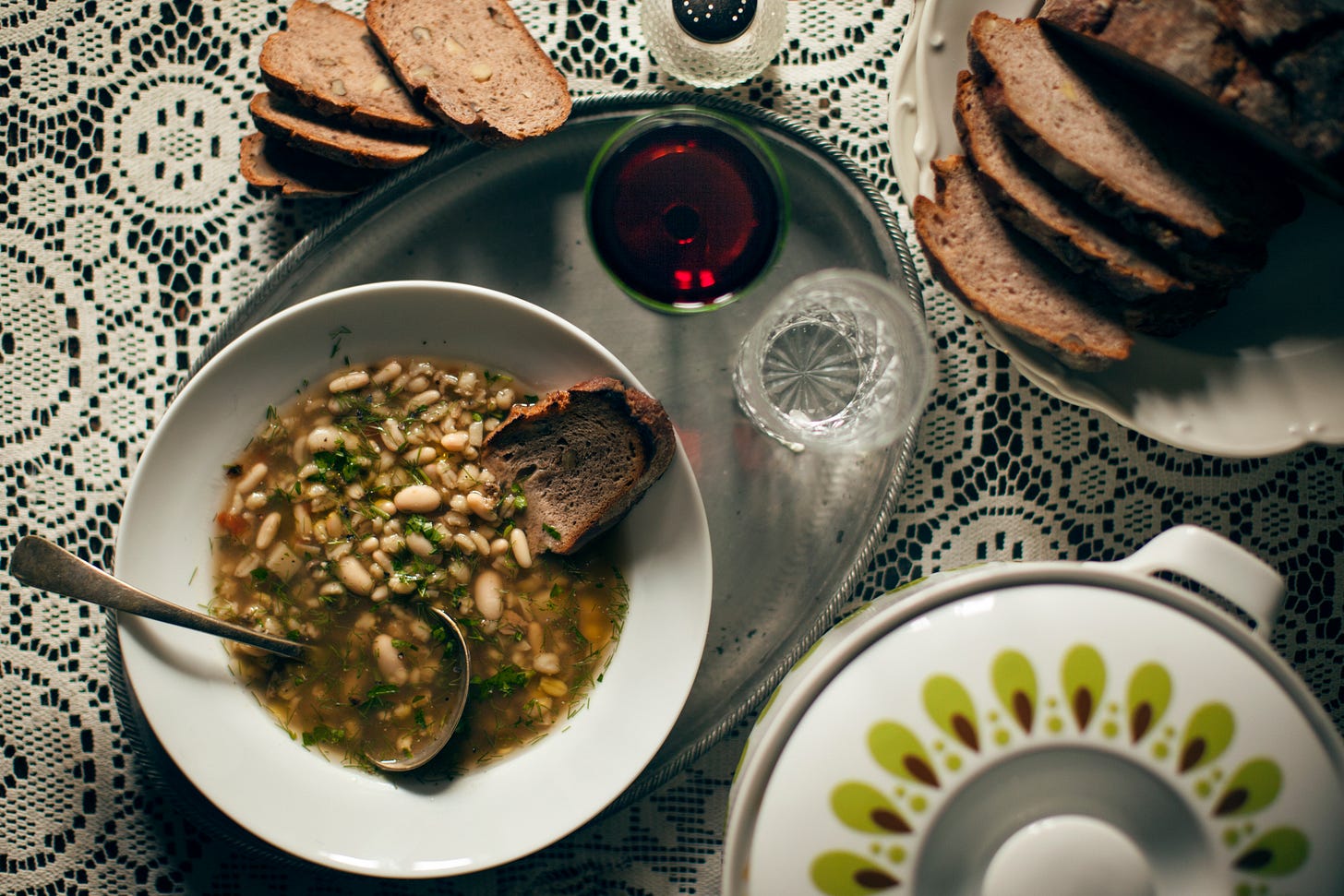
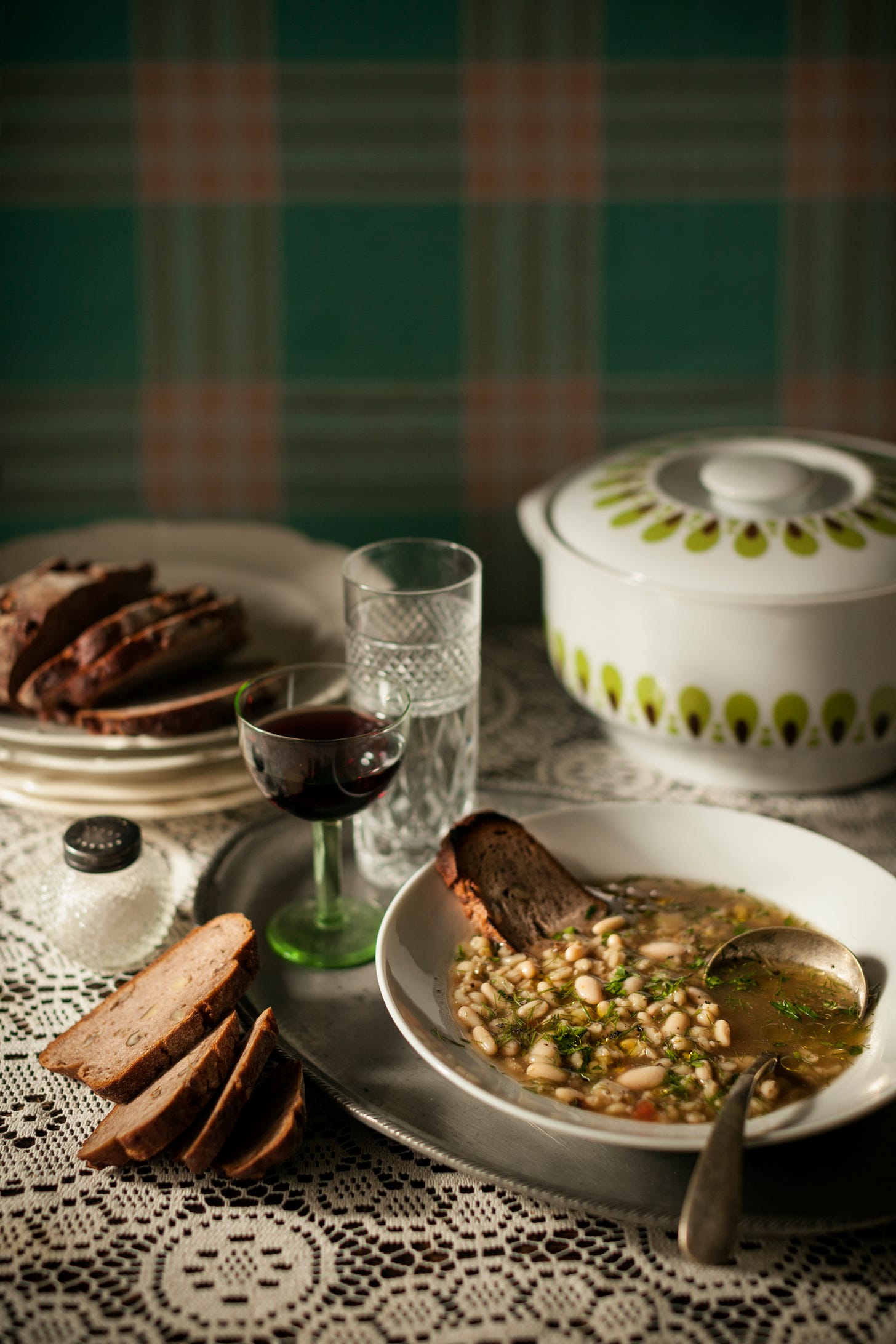
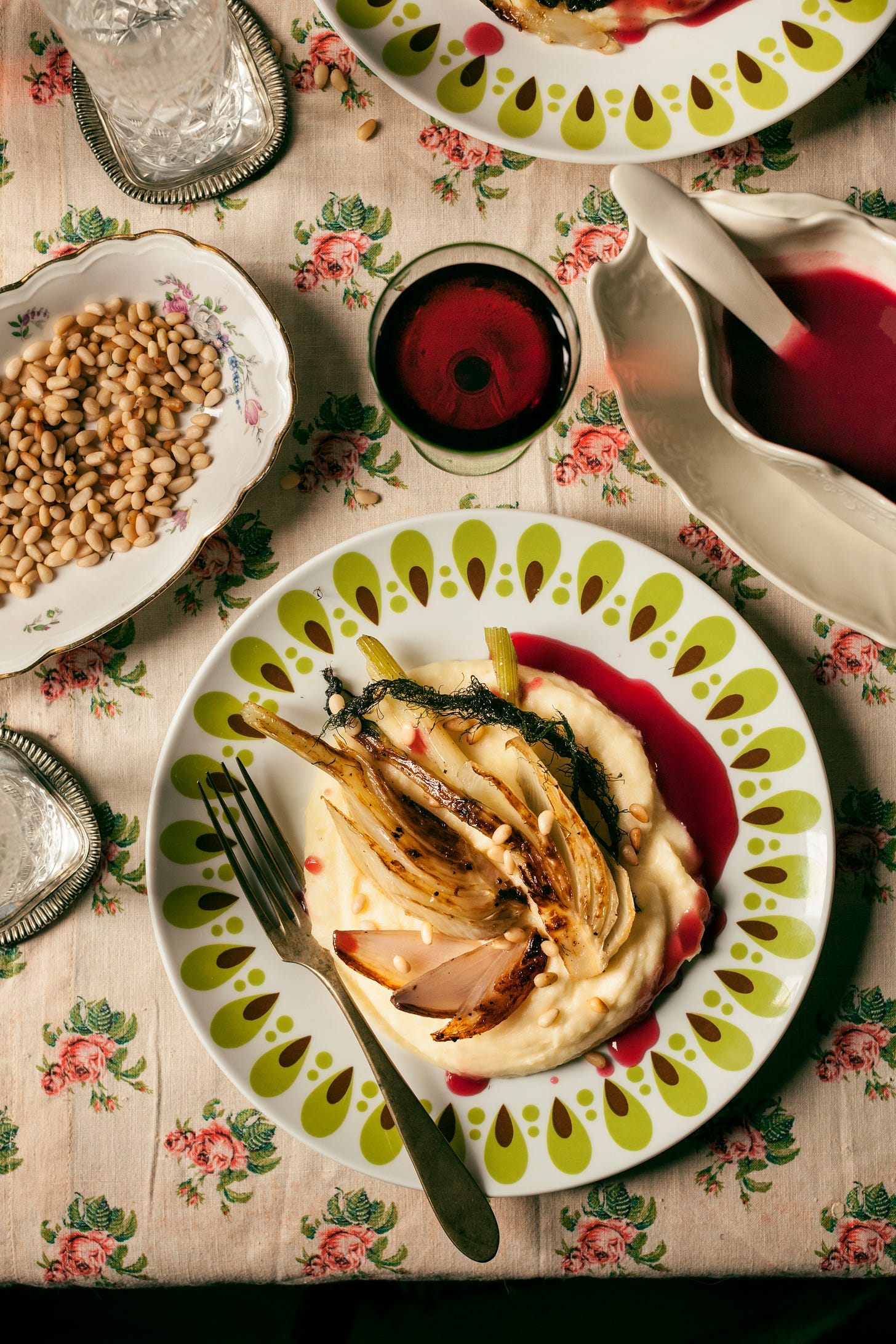
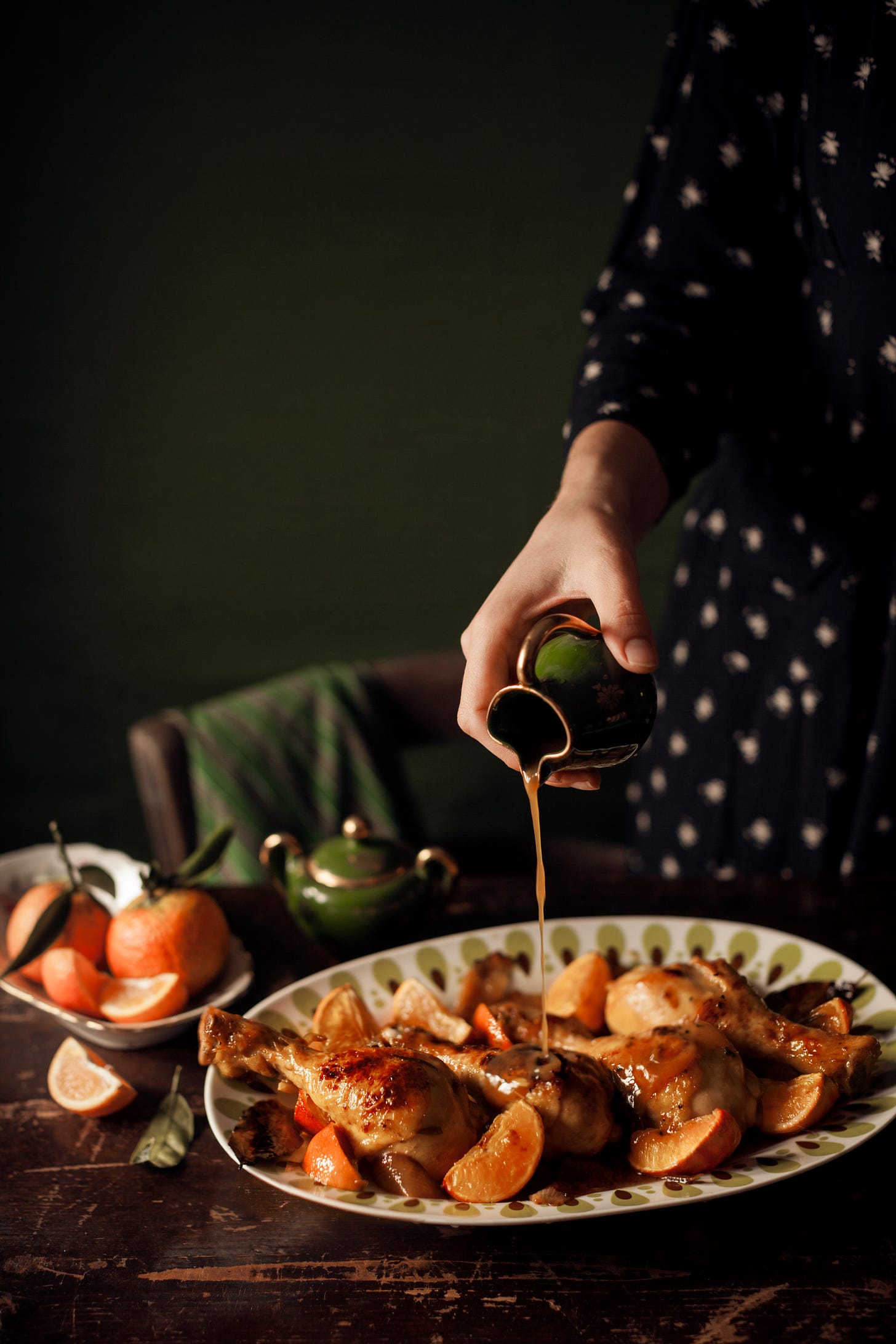
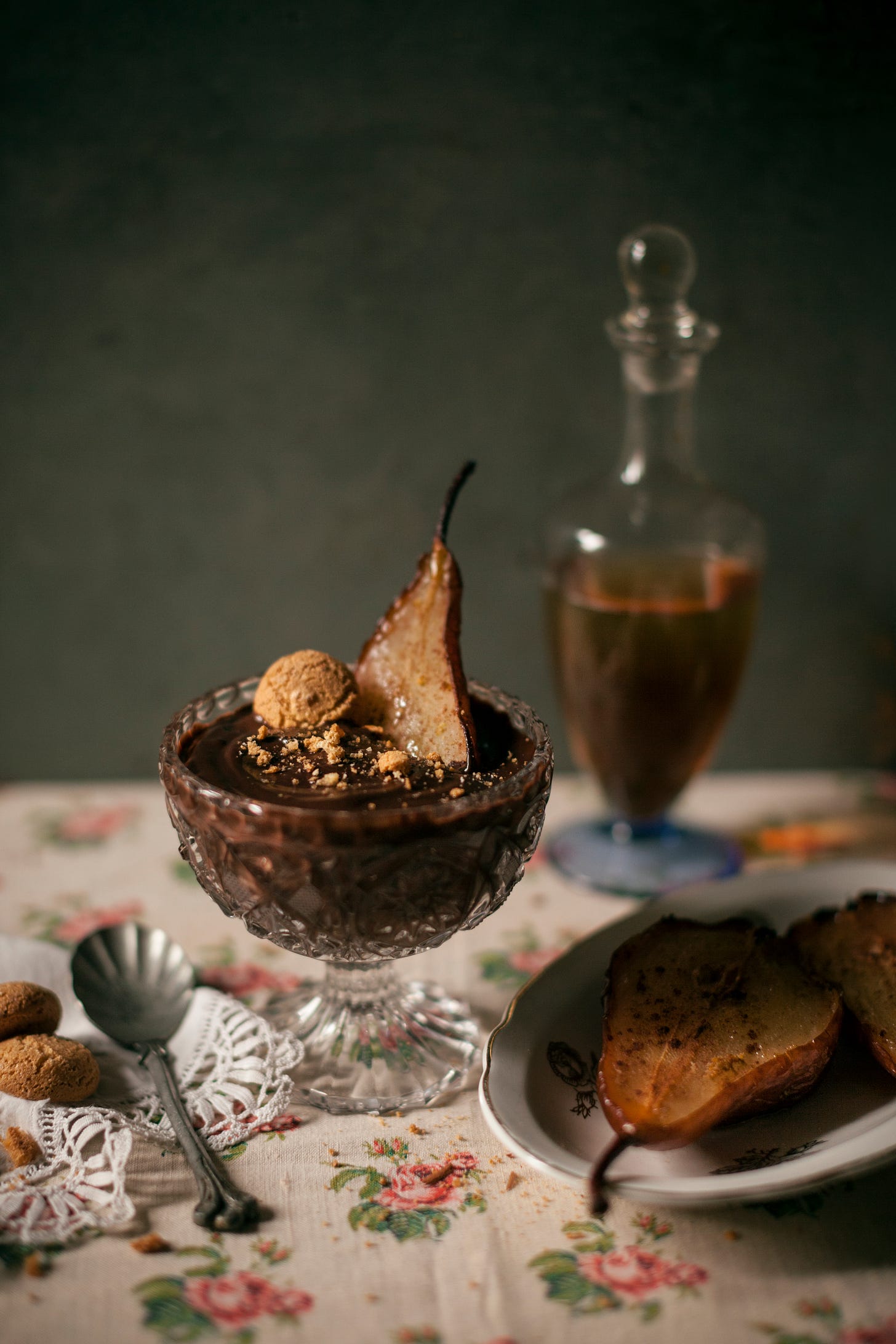
Wow, can you invite us all to dinner?
Welcome to Substack! So happy to find you here and those fabulous recipes of that winter kitchen.